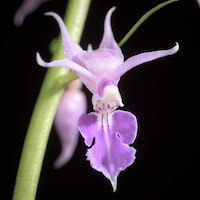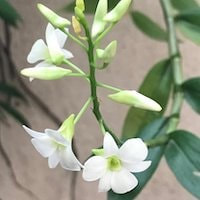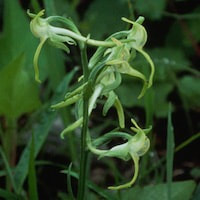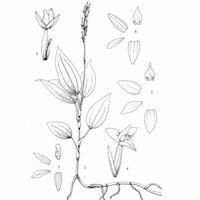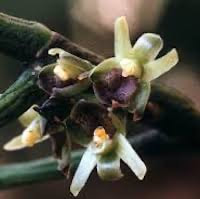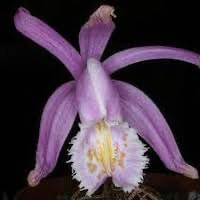WOR11 - Women's Oriental 11 - Frankly, My Dear, I Don't Give a…
|
Native Singaporean Orchid notes: Cattleya Muabu Surprise #1 x LC Mini Purple
Cattleya Muabu Surprise #1 x LC Mini Purple is a striking hybrid orchid featured in the Oriental 11 (Women) team-building perfume workshop. Its standout feature includes large lavender-colored flowers with an exceptionally large lip, creating a visually stunning appearance. Known for its delightful fragrance, this orchid enhances the workshop experience as participants engage in collaborative activities. This hybrid exemplifies the diversity of nature and the art of orchid hybridization, inspiring teamwork, creativity, and innovation. Its inclusion in the workshop cultivates an atmosphere of beauty, harmony, and shared creativity, ensuring a memorable and meaningful event for all participants.
|
Therapeutic Orchid notes:
|
Calanthe puberula Lindl. Syn. Calanthe similis Schltr.
Calanthe puberula Lindl., also known as Calanthe similis Schltr., is a diverse orchid species with numerous Chinese names like Lianexiaji Lan (sickle lip orchid), Fanjuangenjie Lan (counter-folding root segment orchid), and others. Found in Yunnan, Guangxi, and Guandong, it is valued in Chinese Herbal Medicine for its holistic healing properties. Used widely, it serves as an antipyretic to reduce fever, detoxifies the body, and treats conditions such as scrofula and itchy sores. Its medicinal versatility extends to improving blood flow, relieving pain, and addressing issues like ulcers, trauma, and dysentery. In Taiwan and China, Calanthe puberula remains integral to traditional healing practices, preserving cultural heritage and promoting wellness through natural remedies. |
|
Dendrobium ovatum (L.) Kraenzl.
Dendrobium ovatum (L.) Kraenzl., known as Anantali Maravara (van Rheede), Maravar along the Malabar Coast and Uttar Pradesh, and Nagli (Marathi) in India, is a valued orchid species in traditional herbal practices. Historical records from 1703 mention its use for chest pain and stomach ache relief. Today in Mumbai, its entire plant juice is used for stomach ache and as a laxative. In regions like Kudremukh National Park and the Western Ghats, it treats stomach aches. Chemical analysis shows alkaloids in its leaves, likely contributing to its medicinal properties. Its use underscores India's cultural heritage and natural healing practices, benefiting community health and well-being. |
|
Habenaria delavayi Finet
Habenaria delavayi Finet, known as Houbanyufenghua (thick petal jade phoenix flower) in Chinese, holds medicinal value under the names Jishenshen (chicken kidney ginseng) and Duiduishen (paired ginseng). Blooming from May to August in regions like Sichuan, Guizhou, Yunnan, and Tibet, this orchid's tubers are harvested in autumn for their tonic properties. Used fresh or dried, it treats lumbago, kidney weakness, dizziness, tinnitus, hernia, and neurosis. Its traditional use underscores China's botanical knowledge, benefiting health and vitality in local communities. |
|
Hetaeria obliqua Blume
Hetaeria obliqua Blume, known as Xiebanfanchun Lan in Chinese and Pokok tumbak hutan in Malay, is a versatile orchid species found in lowland forests across Sumatra, Thailand, Nicobar Islands, Peninsular Malaysia, and Borneo. In Peninsular Malaysia, its leaves are used to create a poultice for treating sores and infected wounds, showcasing its healing properties. Combined with leaves from another orchid, Thrixspermum pardale, locals use it to treat nose ulcers, demonstrating resourcefulness in traditional medicine. These practices highlight orchids' role in local health traditions, preserving cultural heritage and botanical knowledge for future generations. |
|
Luisia brachystachys (Lindl.) Bl. Syn. Luisia indivisa King & Pantl.
Luisia brachystachys (Lindl.) Bl., also known as Xiaohuachaizigu in Chinese, is a resilient epiphytic orchid with cylindrical stems and leaves. It thrives in southern Yunnan, Thailand, Bhutan, India, Myanmar, and Vietnam, typically at elevations of 600 to 1300 meters. Besides its beauty, this orchid emits a pleasant fragrance and contains perfumery chemicals like methyl 2,4-dihydroxy-6-methylbenzoate and methyl 2,4-dihydroxy-3,6-dimethylbenzoate. In traditional medicine, it serves as a nutrient and emollient, easing rheumatic pain and treating skin issues like boils and tumors with its pounded poultice. Its use highlights the value of orchids in traditional healing practices and their role in cultural heritage and botanical research. |
|
Pleione praecox (Sm.) D. Don
Pleione praecox (Sm.) D. Don, also known as Epidendrum praecox Smith, Coelogyne praecox (Smith) Lindl., Cymbidium praecox (Smith) Lindl., and Coelogyne wallichiana Lindl., holds cultural significance with Nepali name Lasun pate, Shaktigumba, and Myanmar name Phar la tet thitkhwa. This epiphytic orchid thrives on tree trunks or rocks at elevations from 1200 to 2500 meters, spanning Nepal, Bhutan, Northern India, Myanmar, Thailand, and China. In Nepali herbal practices, its pseudobulb is made into a paste for treating cuts and wounds, and as an energizing tonic when mixed with milk, enhancing overall well-being and vitality. The orchid’s use underscores the deep-rooted knowledge and cultural heritage of botanical resources in traditional healing, supporting community health and ensuring its sustainable conservation for future generations. |
Other scent note
Chocolate, white musk, vetiver, Hyrax, Ambertone, Lorenox, spice mix, Banana leaf
Download the guided mediation that works best with this Orchid fragrance oil
| women_oriental_essential_oil_orchi_00011.mp3 | |
| File Size: | 115178 kb |
| File Type: | mp3 |

